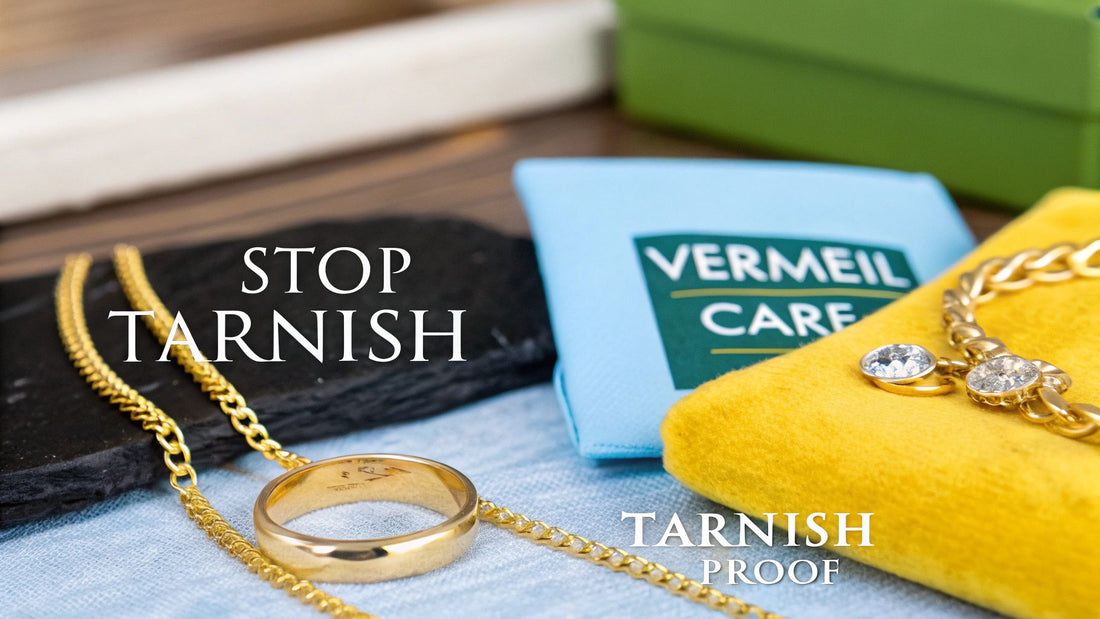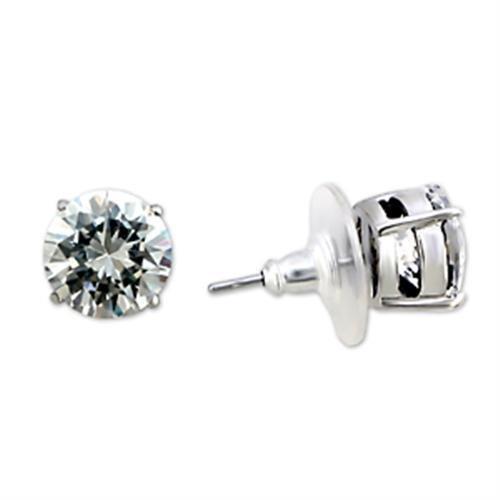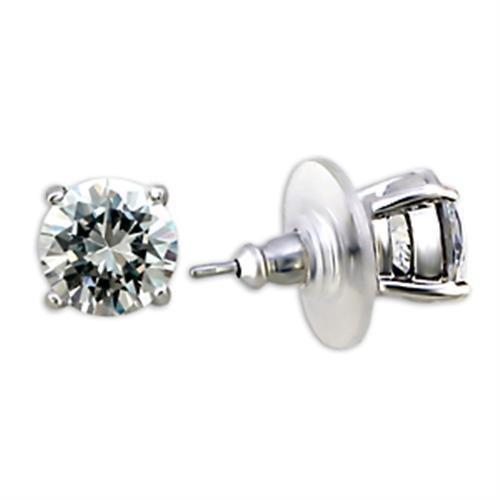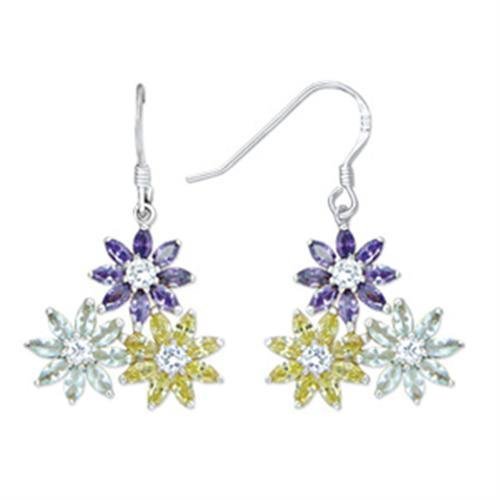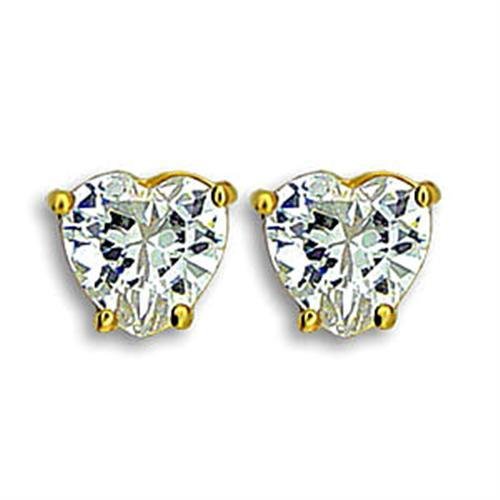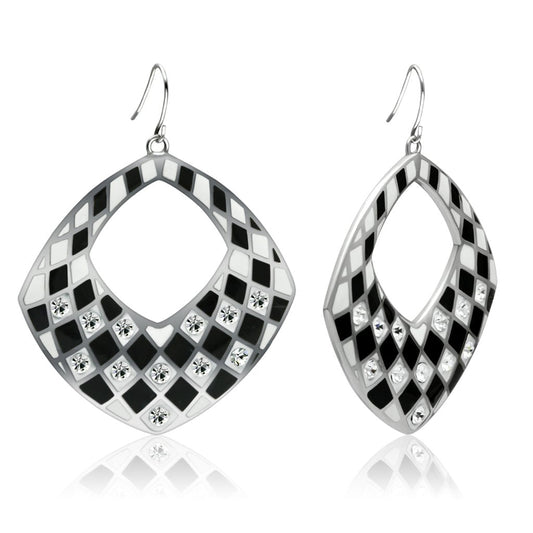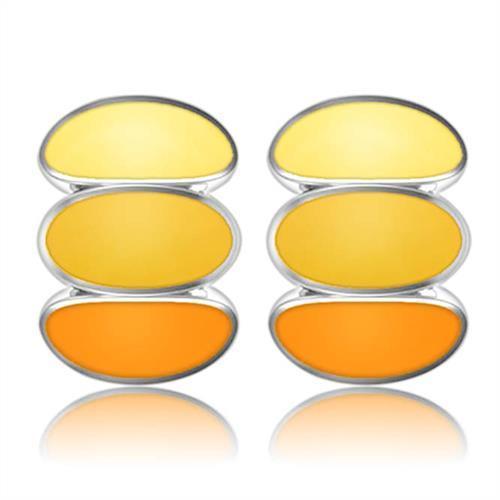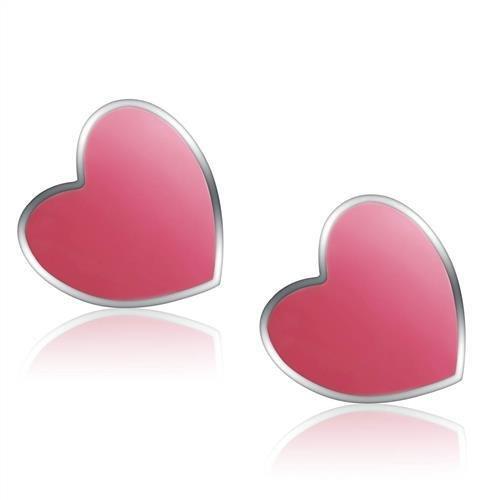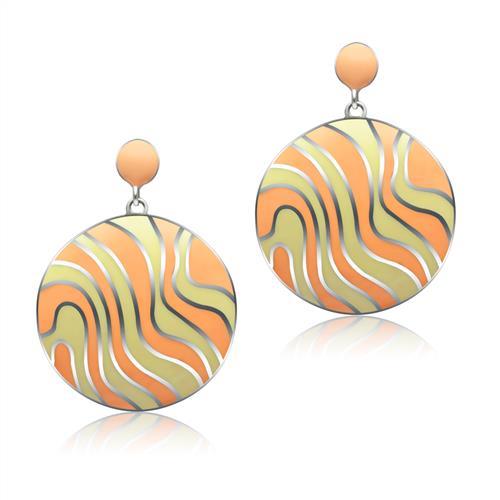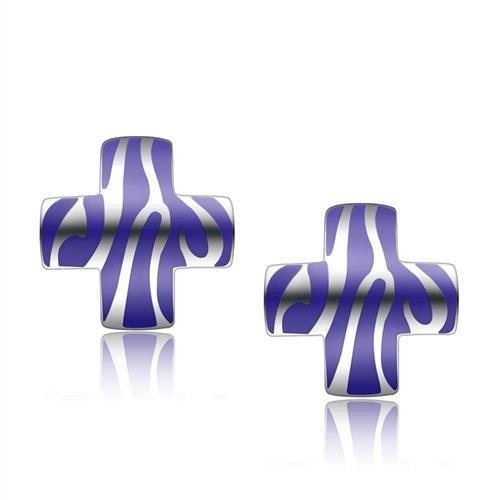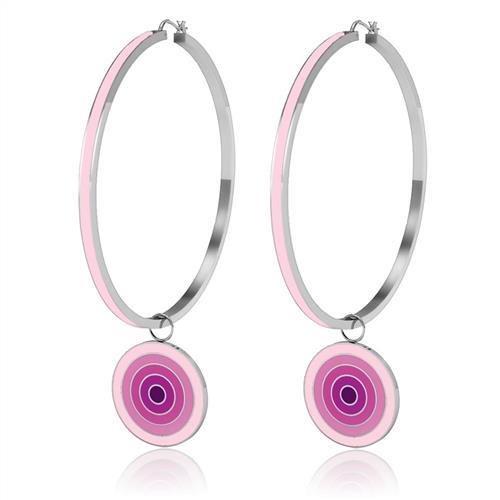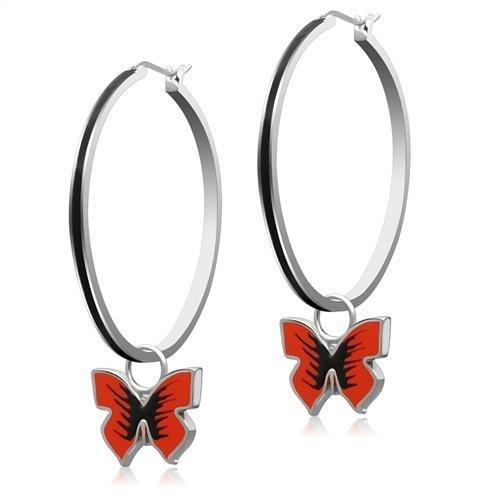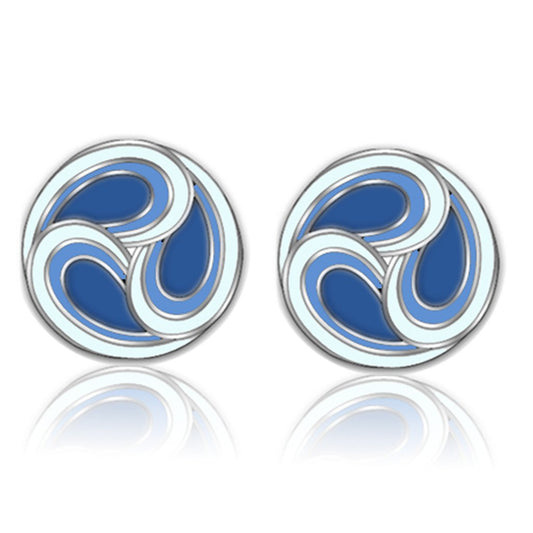Yes, gold vermeil can tarnish over time, but it’s far more resilient than your average gold-plated jewelry. Think of it like a premium weatherproof jacket versus a thin, disposable poncho—both offer some protection, but vermeil provides a much thicker, more durable shield for the precious metal underneath.
The short answer is that while pure gold doesn't tarnish, the sterling silver base of vermeil can. However, the thick gold plating acts as a strong protective barrier, significantly delaying this process. With proper care, your vermeil pieces can maintain their brilliant shine for years.
Does Vermeil Tarnish Compared To Other Gold Jewelry?
The confusion around whether vermeil tarnishes is completely understandable, mostly because not all gold jewelry is created equal. The real difference is baked right into its construction, and understanding this helps you see why vermeil is a superior choice.
Gold vermeil is a specific category of demi-fine jewelry. To earn the name, it must have a sterling silver base and a substantial layer of gold plating that's at least 2.5 microns thick. Compare that to standard gold-plated pieces, which can have a gold layer as thin as 0.5 microns, and you can see why vermeil stands in a class of its own.
This robust construction is a major reason why vermeil is so much more resistant to tarnishing. For more insights on this industry standard, check out this guide from Gold Urban.
This distinction places vermeil in a unique sweet spot between affordable gold-plated items and pricey solid gold. To make it even clearer, let's break down the core differences between the three.
Vermeil vs Gold-Plated vs Solid Gold At a Glance
This table breaks down the core differences between the three main types of gold jewelry to help you understand their value and durability.
| Attribute | Gold Vermeil | Gold-Plated | Solid Gold |
|---|---|---|---|
| Base Metal | Sterling Silver | Brass, Copper, or Zinc | Gold Alloy (e.g., 14k, 18k) |
| Gold Thickness | 2.5 microns or more | 0.5 microns (often less) | Solid throughout, no plating |
| Durability | High | Low | Very High |
| Tarnish Resistance | Good to excellent | Poor | Excellent (doesn't tarnish) |
| Value | Mid-range (demi-fine) | Low (costume jewelry) | High (fine jewelry) |
| Hypoallergenic | Generally yes (sterling silver base) | Often no (base metals can react) | Yes |
As you can see, vermeil offers a fantastic balance of durability, quality, and value, making it a superior choice over standard plating.
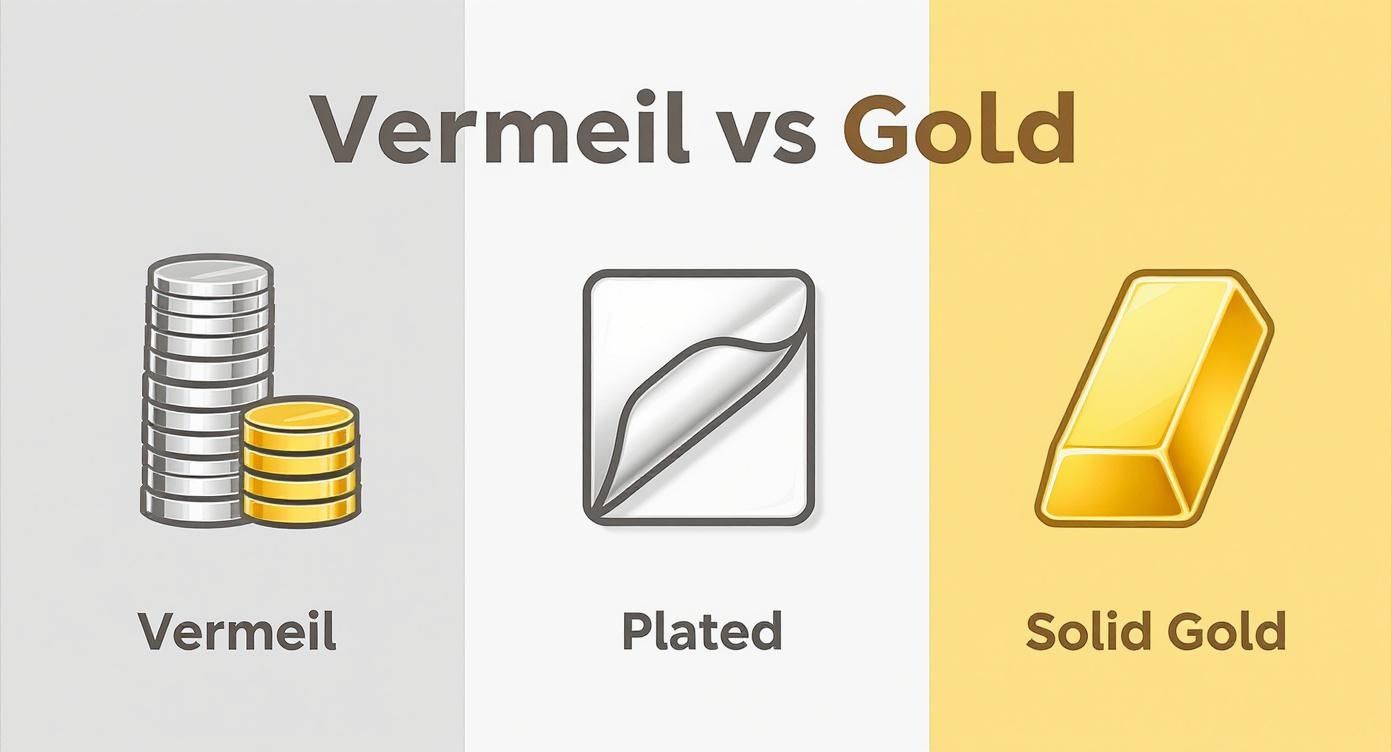
What This Means For You
Choosing vermeil means you're investing in a piece that gives you the luxurious look and feel of solid gold with far greater longevity than typical plated alternatives. It's the ideal choice for building a high-quality jewelry collection without the expense of solid gold.
At Precious Pulse Jewelry, our collection is crafted to meet these high standards, ensuring your favorite pieces keep their brilliant shine for years to come. While tarnish is a possibility over the long term, its slow progression and high resistance make vermeil a smart and beautiful choice for your collection.
What Makes Gold Vermeil Different
So, what exactly sets vermeil apart from other gold jewelry you see online or in stores? It’s not just a fancy name—it's a legally defined standard of quality that combines two precious metals: a solid sterling silver core topped with a seriously thick layer of real gold.
To officially earn the vermeil (pronounced ver-may) label here in the United States, a piece has to meet two strict rules. The gold layer must be at least 10 karats, and it has to be a substantial 2.5 microns thick. A micron is incredibly tiny—one-millionth of a meter—but in the world of jewelry, that small measurement makes all the difference in how your piece wears over time.
The Power of Thickness
Why is that 2.5-micron layer so important? Think of it like a high-quality weatherproof jacket. A thin, cheap windbreaker might keep you dry in a light drizzle, but it won’t stand up to a real storm. A thick, durable raincoat, on the other hand, creates a reliable shield that protects you from the elements.
It's the same idea here. The thick gold layer in vermeil acts as a robust barrier, protecting the reactive sterling silver underneath from the air and moisture that cause tarnish. This is the secret to its longevity and what makes it far superior to standard gold-plated jewelry, which often has a gold layer as thin as 0.5 microns and can wear away in months.
This regulated thickness is precisely why vermeil is considered "demi-fine" jewelry. It perfectly bridges the gap between fleeting costume jewelry and expensive solid gold, offering lasting luxury at a much more accessible price.
This unique construction gives you the rich look and substantial feel of solid gold without the sky-high cost. Understanding this is key to knowing why the question "does vermeil tarnish?" has a more layered answer than you might think. To dive deeper, you can learn more about what vermeil jewelry is in our detailed guide. This knowledge will help you appreciate the craftsmanship and value behind every piece in our Precious Pulse Jewelry collection.
The Real Reason Your Jewelry Tarnishes
To get to the heart of why vermeil might eventually tarnish, we need to look past its beautiful gold surface and see what’s going on underneath. Gold itself is incredibly resistant to tarnish; pure gold is one of the least reactive metals out there. The real culprit is the sterling silver core.
Think of it like a beautifully painted iron gate. That vibrant paint is like the gold layer on your jewelry—protective and brilliant. But if daily wear and tear creates a scratch, the iron underneath gets exposed to air and moisture, and rust eventually forms. This is the perfect way to understand how tarnish happens on vermeil.
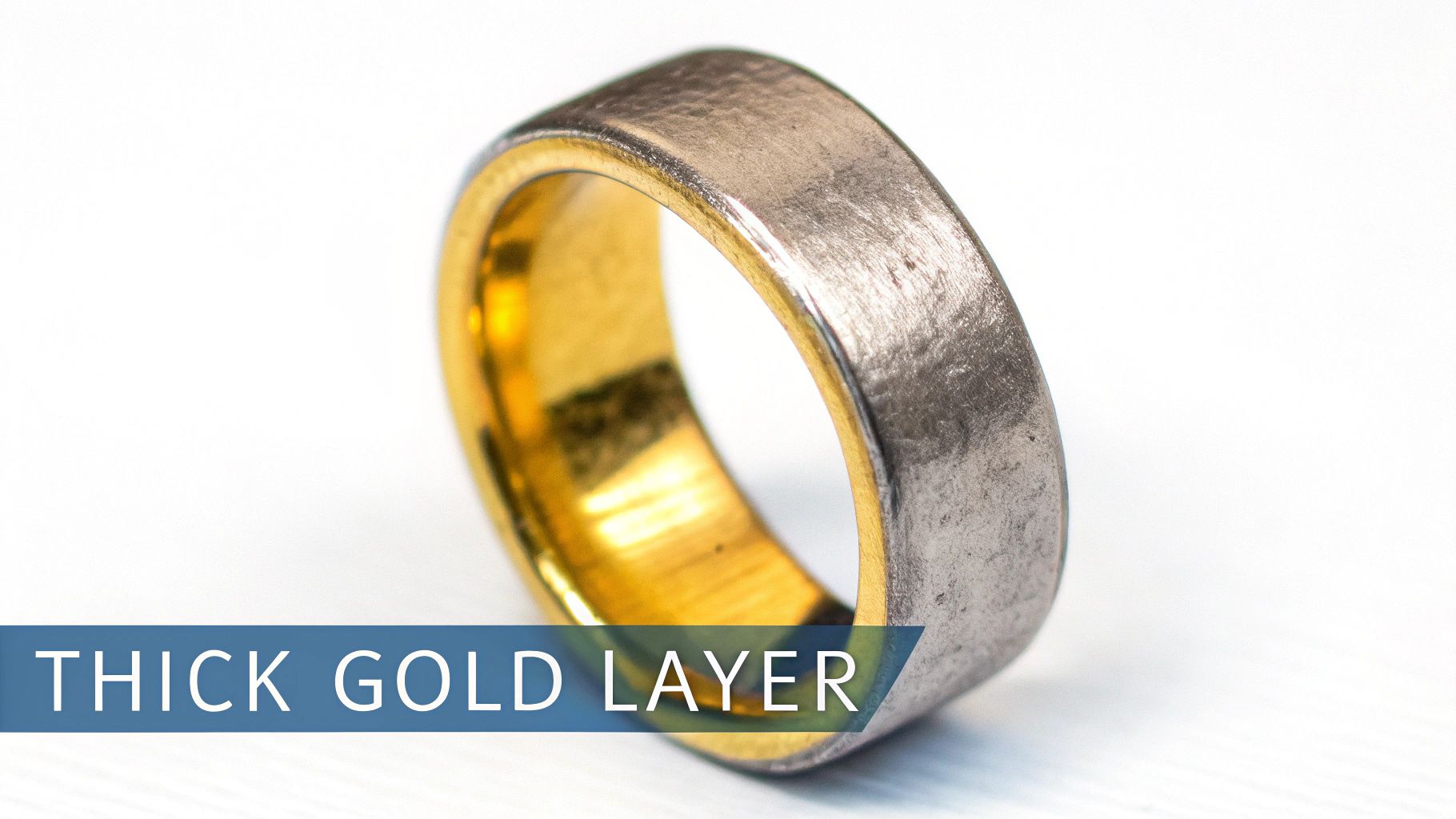
How Tarnish Actually Forms
Tarnish isn’t dirt; it’s a chemical reaction playing out on your jewelry. It happens when friction, chemicals, or even just long-term wear thins the gold layer, exposing the sterling silver base. This silver then reacts with sulfur compounds floating around in the air or found on your skin and in certain products.
This reaction creates a dark layer called silver sulfide—what we see as tarnish. It’s why even the highest quality pieces need a little TLC to stay looking their best.
For a deeper dive, our guide on what causes jewelry to tarnish in our comprehensive guide covers all the factors that can speed up this process.
Key Takeaway: It's not the gold that tarnishes, but the sterling silver base metal reacting with its environment. The thick gold layer on vermeil acts as a strong shield, significantly delaying this process.
Because of the metals involved, this reaction is sometimes confused with the green tint some jewelry can leave behind. To clear things up, it’s helpful to understand why jewelry turns your skin green, which is a totally different chemical process.
Ultimately, knowing that the sterling silver base is the reactive element makes it clear why protecting that outer gold layer is so crucial. That’s the secret to keeping your vermeil pieces brilliant and beautiful for years to come.
Everyday Habits That Accelerate Tarnishing
Even the highest quality vermeil isn't invincible, and some of our most common daily routines can actually speed up the tarnishing process. Think of it this way: the thick gold layer is like a shield, but certain habits can slowly chip away at its defenses. Knowing what these triggers are is the first step to keeping your jewelry looking brilliant for years to come.
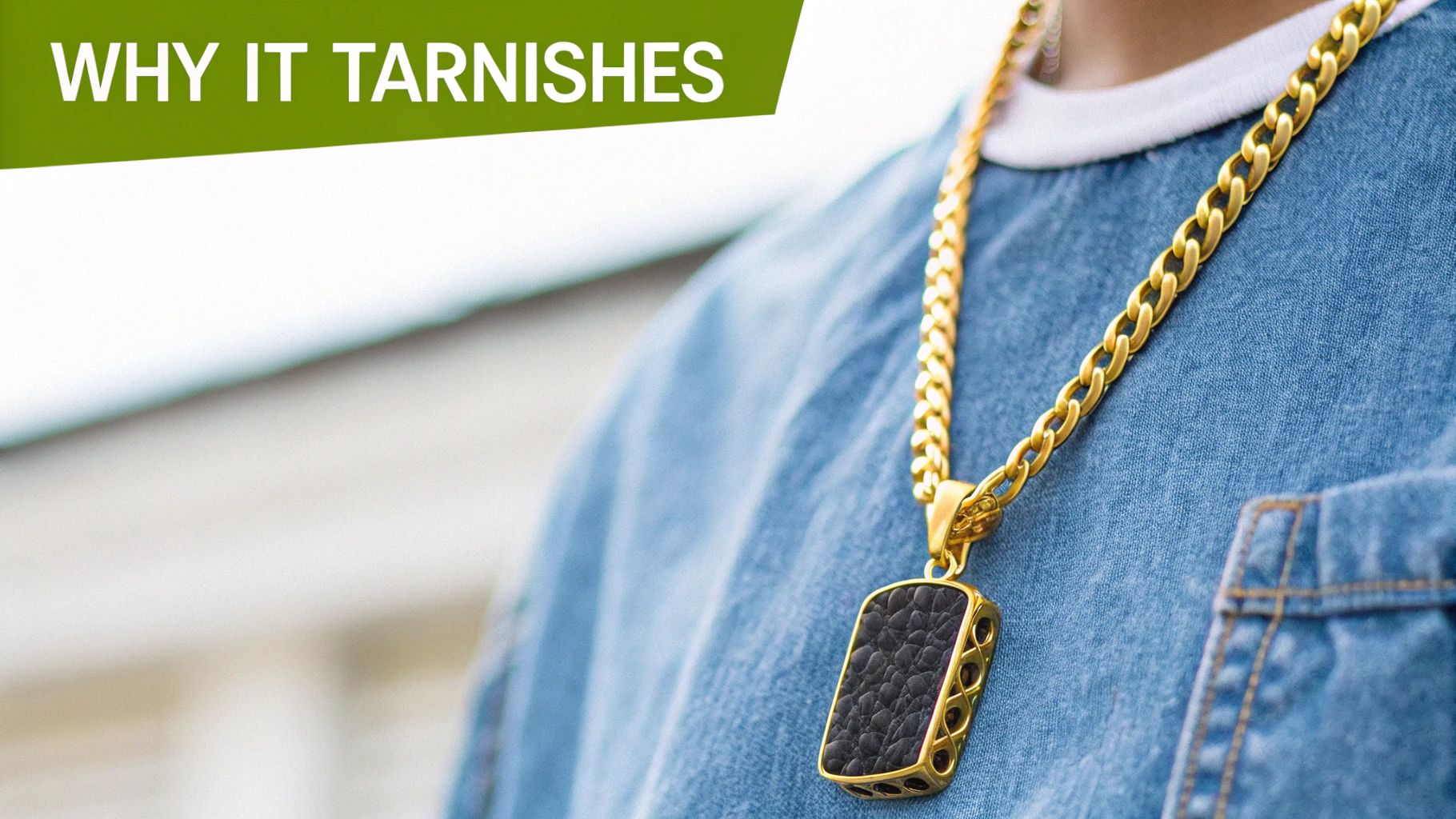
Many of these culprits are probably part of your daily life already. They act like tiny assailants, gradually weakening the protective gold layer and letting air and moisture creep in to react with the sterling silver base.
Here are the hidden dangers to watch out for:
- Moisture Exposure: Wearing your vermeil pieces in the shower, pool, or even during a sweaty workout is a fast track to tarnish. All that moisture accelerates the chemical reaction that causes discoloration.
- Chemical Contact: Your favorite perfumes, lotions, hairsprays, and even household cleaning agents contain chemicals that can be corrosive. Over time, they can break down the gold finish.
- Natural Oils and Sweat: Your skin’s own oils and perspiration are acidic and can react with the metals in your jewelry. This is especially true for pieces you wear all the time, like your favorite rings.
Climate and Environmental Factors
It's not just about what you do—it's also about where you live. Your environment plays a surprisingly big role in how quickly your jewelry shows signs of wear. High humidity, for instance, is a major catalyst because it blankets everything in a constant, invisible layer of moisture.
Believe it or not, where you live can make a huge difference. In tropical regions with an average humidity above 70%, vermeil jewelry is 25% more likely to tarnish within 18 months compared to pieces worn in drier, more temperate climates. That’s all thanks to the increased oxidation and moisture in the air. You can find more insights on how climate affects jewelry on Helzberg.com.
Pro Tip: If you live somewhere humid, proper storage isn't just a suggestion—it's essential. Keeping your jewelry in an airtight container or a special anti-tarnish pouch can make a massive difference in its longevity.
By becoming more aware of these seemingly harmless habits, you can take proactive steps to defend your jewelry. The goal isn’t to stop wearing your favorite pieces, but to build small, protective habits into your routine. Our Precious Pulse Jewelry collection is crafted for durability, but a little mindfulness will ensure each piece remains a stunning part of your collection for the long haul.
A Simple Care Routine for Lasting Shine
Keeping your gold vermeil looking brilliant is far simpler than you might think. It’s not about complicated procedures or special tools—it’s about building a few mindful habits into your daily routine. With just a few small, preventative steps, you can keep that protective gold layer strong and your jewelry looking incredible.
The easiest principle to remember is the “Last On, First Off” rule. Think of your jewelry as the finishing touch. It should be the very last thing you put on after your lotions, perfumes, or hairspray have settled. At the end of the day, it should be the first thing you take off before changing, showering, or hopping into bed.
Daily Upkeep and Gentle Cleaning
For day-to-day maintenance, a quick wipe-down with a soft, dry, lint-free cloth after each wear is all you need. This simple action clears away the skin oils, sweat, and moisture that can slowly build up and contribute to tarnishing over time.
When your pieces need a little more love, a gentle soap-and-water method is the perfect way to restore their luster without causing any harm.
- Prepare the Solution: Mix a few drops of mild dish soap into a bowl of warm water.
- Clean Gently: Dip a soft cloth into the solution and gently wipe the jewelry. No scrubbing needed!
- Rinse Thoroughly: Use a separate cloth dampened with plain water to wipe away any soap residue.
- Dry Completely: This is the most important step. Pat the jewelry dry with a clean, soft cloth, making sure absolutely no moisture is left behind.
Crucial Tip: Stay far away from harsh chemical cleaners, ultrasonic machines, or abrasive cloths. These are far too aggressive for vermeil and can easily strip away the delicate gold layer, causing permanent damage.
Proper storage is your final line of defense against tarnish. When you’re not wearing your pieces, keep them in an airtight container, like a dedicated jewelry box or a soft pouch. This protects them from the humidity and airborne elements that can dull their shine over time.
For a deeper dive into maintaining your pieces, you can find more expert tips on how to clean gold jewellery. And if you're curious about other protective finishes that keep jewelry looking its best, check out our article on what rhodium plating is in our article.
How to Restore Already Tarnished Vermeil
So, you’ve noticed a bit of discoloration on your favorite vermeil piece. Don't panic! It’s often completely reversible, especially if you catch it early. A simple rescue plan can bring back that beautiful, original shine.
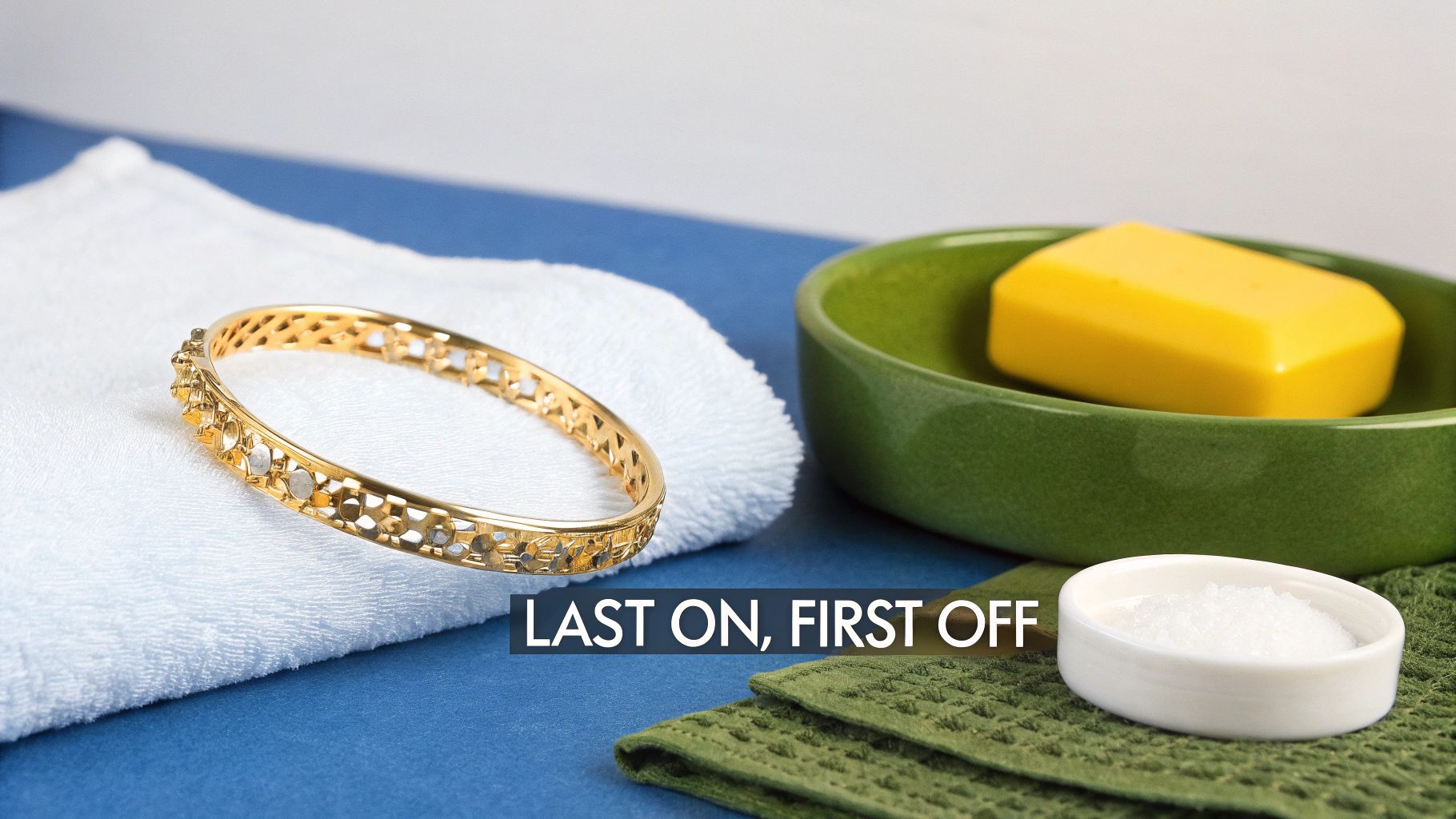
If you're just dealing with minor dullness, a specialized jewelry polishing cloth is your best friend. These are designed specifically for precious metals and can work wonders. Gently rub the surface in small, circular motions. The key here is to be gentle—aggressive scrubbing can wear down the gold layer. More often than not, this simple step is all it takes to lift light tarnish.
When to Seek Professional Help
But what if the tarnish is more significant, or you're seeing signs that the gold layer itself is wearing thin? This is when it's time to step back and consult a professional. Trying to tackle heavy tarnish at home can easily do more harm than good, risking permanent damage to the piece. A reputable jeweler has the tools and expertise to assess the wear and map out the best course of action.
For more advanced wear, the most effective solution is almost always professional replating. It’s a straightforward process that works like a factory reset for your jewelry:
- First, the piece is meticulously cleaned to remove every last trace of oil, dirt, and tarnish.
- Next, a new, thick layer of gold is electroplated onto the sterling silver base.
This isn't just a cleaning; it’s a full restoration. The process brings your jewelry back to its original, fresh-from-the-box finish, making it look brand new again. While the cost can vary, replating is a fantastic way to breathe new life into a cherished item.
This is where investing in high-quality vermeil from the start really pays off. Pieces from our Precious Pulse Jewelry collection are crafted with a robust gold layer, making them far more resilient and much less likely to need frequent restoration. That commitment to quality means better long-term value and more time enjoying your jewelry.
Your Top Vermeil Questions, Answered
To wrap things up, let's tackle a few of the most common questions we hear about gold vermeil. Think of this as your quick-reference guide.
How Long Does Gold Vermeil Last Before Tarnishing?
With proper care, your gold vermeil jewelry can stay brilliant for many years. For pieces you wear daily, you can expect them to maintain their finish for 2-3 years before showing signs of significant wear. For items worn less frequently and stored carefully, that lifespan can extend to 5-10 years or even longer. The key factors are how often you wear it and how well you protect it from moisture and chemicals.
Can You Wear Gold Vermeil in the Shower?
This is a big one, and the answer is a firm no. It’s one of the fastest ways to degrade the finish. The combination of water, heat, steam, and chemicals from soaps and shampoos will accelerate the breakdown of the gold layer, exposing the sterling silver underneath and leading to tarnish. To keep your vermeil looking its best, always remove it before showering, swimming, or exercising.
The question "does vermeil tarnish" really comes down to your daily habits. Keeping it dry is the single most important thing you can do to protect its luster for the long haul.
Is Gold Vermeil Better Than Gold-Plated Jewelry?
Yes, absolutely. Gold vermeil is in a completely different league when it comes to quality, durability, and value.
The crucial difference lies in the standards: vermeil legally requires a thick layer of gold (at least 2.5 microns) over a precious sterling silver base. In contrast, standard gold-plated jewelry has a much thinner layer of gold (often less than 0.5 microns) over a less valuable base metal like brass or copper. This makes vermeil more durable, hypoallergenic, and a far better long-term investment.
Ready to invest in jewelry that offers lasting beauty without the solid-gold price tag? The Precious Pulse Jewelry collection is crafted with high-quality vermeil designed to stand the test of time. Explore our stunning necklaces, rings, and bracelets today at https://preciouspulsejewelry.com.

